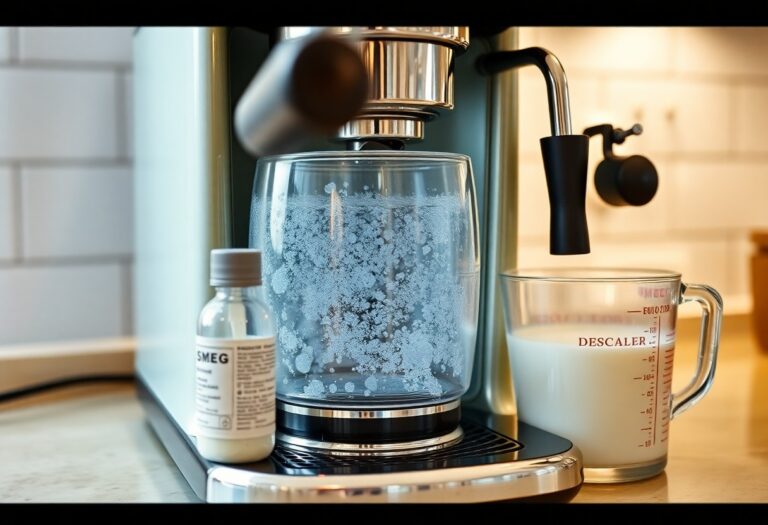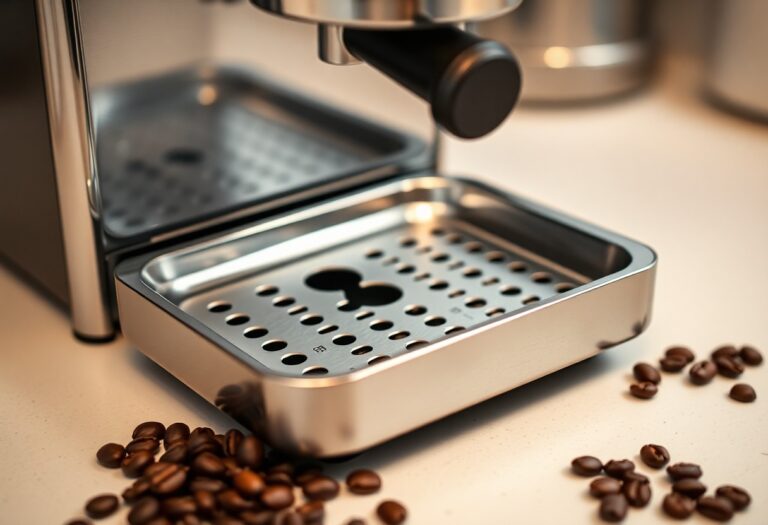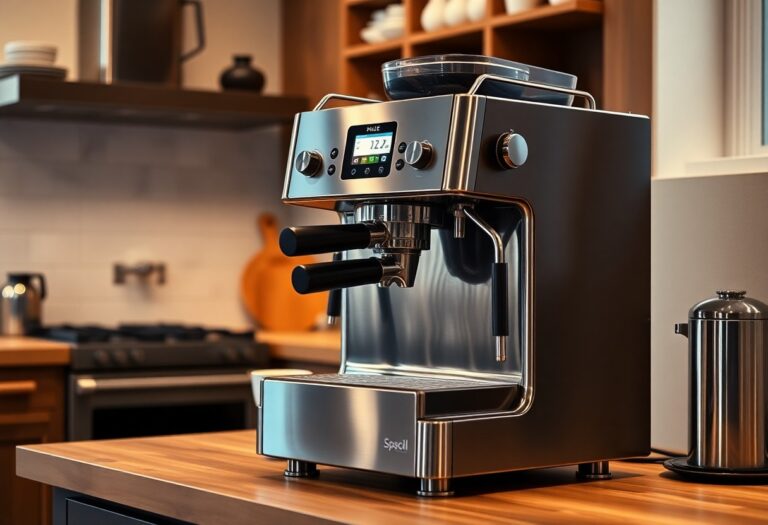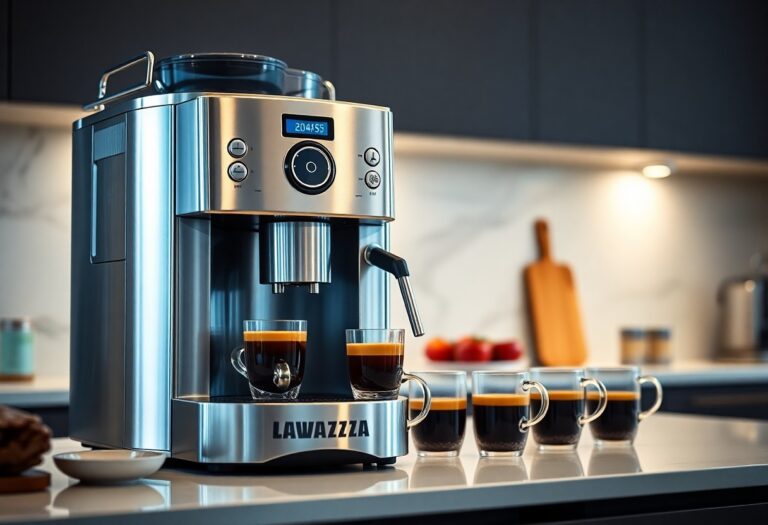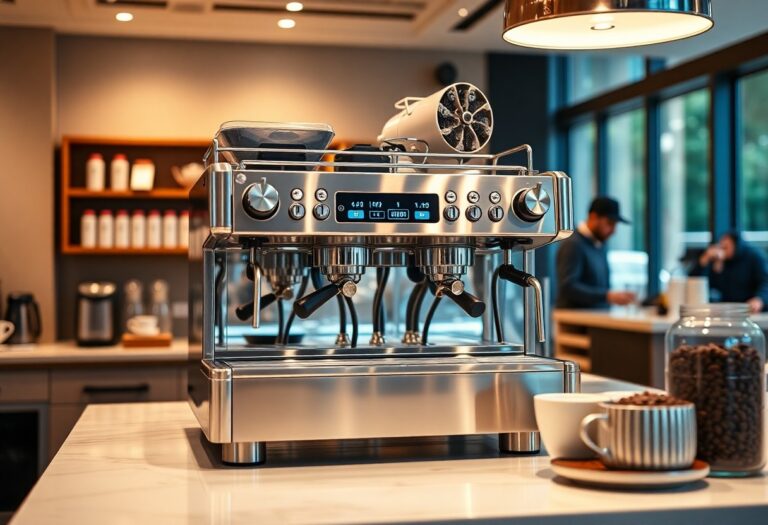What Does a Coffee Machine Do – Basic Functions
A machine designed specifically for brewing coffee, the coffee machine transforms your humble coffee grounds into a rich, aromatic beverage. By applying heat and pressure, it extracts flavor and caffeine while allowing you to customize brew strength and temperature to align with your personal preferences. Using a coffee machine not only provides convenience but also ensures consistency, making it a favorite in many households. However, always follow safety precautions to avoid potential burns or equipment malfunctions, ensuring you enjoy your cup joyfully and safely.
Key Takeaways:
- A coffee machine primarily heats water to the optimal temperature for brewing.
- It mixes hot water with ground coffee to extract flavors and aromas.
- Users can select different brewing methods, such as espresso, drip brewing, or French press, depending on the machine type.
- Many coffee machines offer programmable settings for customization, including brew strength and timing.
- Post-brew, the machine typically keeps the coffee warm through a warming plate or thermal carafe.
The Science Behind Brewing Coffee
Understanding the science behind brewing coffee elevates your experience, ensuring each cup delivers optimal flavor and richness. Several factors come into play during the brewing process, profoundly impacting the final taste and aroma of your coffee. From the water temperature you use to brewing time and extraction, each aspect contributes to the overall chemistry of flavor development. Experimenting with these variables can lead to discovering your perfect brew profile.
The Role of Water Temperature
Water temperature directly influences the extraction of flavor compounds from coffee grounds. Typically, water heated between 195°F and 205°F (90°C to 96°C) optimizes the extraction process, dissolving necessary oils and acids for maximum flavor. Below this range, your coffee may taste sour due to under-extraction, while water exceeding 205°F risks burning the coffee, leading to a bitter yet flat taste. Adjusting the temperature creates a more balanced cup.
| Temperature Range | Effect on Flavor |
| Below 195°F | Under-extraction, sour taste |
| 195°F – 205°F | Optimal extraction, balanced flavor |
| Above 205°F | Over-extraction, bitter taste |
Brewing Time and Extraction
Brewing time is another vital factor that influences extraction, where different brewing methods dictate varying immersion periods. For instance, a French press typically requires around 4 minutes, allowing adequate contact time for flavors to meld. In contrast, espresso is brewed in only 25-30 seconds, necessitating a finely ground coffee to achieve balance. Over or under-extraction during these time frames can result in bitter or sour notes overpowering desirable flavors.
Understanding the balance between brewing time and flavor extraction opens up possibilities for creating a consistently pleasing cup of coffee. Each brewing method demands its specific time to properly release the aromatic oils and flavors locked within the beans. Too short a time leads to insufficient extraction, resulting in a watery, tasteless brew. Conversely, prolonged contact risks extracting unwanted bitter compounds, leading to a harsh taste. Experimenting with your method and timing solidifies your mastery of brewing coffee to achieve the desired flavor profile consistently.
Essential Components of Coffee Machines
Your coffee machine consists of several key components that work together to create the perfect cup of coffee. The main parts include the water reservoir, heating element, brew group, grinder, and coffee grounds container. Understanding how these elements function helps you appreciate the complexity behind brewing and enables you to optimize your coffee-making process for maximum flavor extraction.
The Mechanisms of Grinding
The grinding mechanism is foundational to achieving the ideal coffee taste. You have two main options: blade grinders and burr grinders. Burr grinders provide a consistent grind size, whereas blade grinders may lead to uneven grounds. The grind size influences extraction rates, with finer grinds releasing flavors more quickly than coarser ones. Investing in a quality grinder can significantly enhance your brewing experience.
Understanding the Brewing Process
At the heart of your coffee machine’s operation lies the brewing process, which combines hot water with coffee grounds to extract flavors and aromas. The method begins when water is heated to the optimal temperature, typically around 195°F to 205°F. Subsequently, this hot water is forced through the grounds, allowing crucial oils and acids to infuse into your brew, resulting in rich, bold flavors and nuances unique to your chosen coffee beans.
A deeper look into the brewing process reveals several variables that influence your coffee’s taste, such as water temperature, brew time, and coffee-to-water ratio. Each of these elements plays a pivotal role in achieving your desired flavor profile. For instance, a longer brew time may yield a stronger, more robust cup, while shorter timings can result in a lighter taste. Mastering these nuances allows you to customize your coffee experience and enjoy a cup that perfectly matches your preferences.

From Beans to Brew: The Journey Explained
The journey from raw coffee beans to your cup of brew is a fascinating process that transforms simple ingredients into a flavorful experience. After roasting, beans undergo grinding, where their flavor compounds are unlocked. Once ground, the coffee interacts with water during brewing, extracting important oils and flavors. Understanding each stage enhances your appreciation of the final product, allowing you to enjoy not only the taste but the artistry behind each cup.
The Importance of Fresh Coffee Grounds
Using fresh coffee grounds significantly influences the quality of your brew. The moment coffee is ground, it begins to oxidize, leading to a loss of flavor and aroma. Striving for the freshest taste means grinding your beans just before brewing. This practice retains the important oils and flavors that make your coffee vibrant and aromatic, creating a delightful drinking experience.
The Impact of Grind Size on Flavor
The grind size of your coffee directly affects the extraction process and ultimately, the flavor profile of your brew. A finer grind increases the surface area exposed to hot water, leading to quicker extraction, while a coarser grind slows it down. Each brewing method calls for its specific grind size; for instance, espresso requires a fine grind for optimal extraction, whereas French press coffee benefits from a coarser option. Achieving the right balance ensures you extract the flavors you desire and avoid bitterness or under-extraction.
Adjusting grind size can also alter flavor complexity. If your grind is too fine for certain methods, you might experience a bitter and overly strong cup, while a grind that’s too coarse may lead to a weak and underwhelming brew. For instance, a standard drip coffee maker is typically suited for a medium grind; using a fine grind can result in over-extraction and undesirable bitterness. Conversely, with a French press, a coarser grind allows for the right extraction time and flavor balance, bringing out the subtle notes in your coffee beans. Perfecting your grind size opens up a world of flavor possibilities, allowing you to tailor your coffee experience to your preference.
Automation and User Experience in Modern Machines
Modern coffee machines have revolutionized the way you prepare your favorite brews through advanced automation, enhancing user experience significantly. These machines can now deliver bespoke coffee at the touch of a button, allowing for precise control over strength, temperature, and brew time. Features like built-in grinders and milk frothers make the process seamless, and touch screens display step-by-step instructions, minimizing guesswork and optimizing your experience.
Smart Features Enhancing Coffee Preparation
Smart technology in coffee machines allows you to control your brewing process remotely through mobile apps. This includes programming brew times, adjusting settings, and even ordering coffee supplies. Some machines are equipped with sensors that detect the freshness of beans, ensuring each cup is crafted from optimal ingredients, aligning perfectly with your taste preferences.
The Influence of Personalization on User Preferences
Personalization plays a vital role in enhancing your coffee experience. Many modern machines allow you to save individual profiles that cater to specific taste preferences, ensuring that each cup is tailored to your liking without the need for constant adjustments.
With the rise of customizable settings, you have the power to save your favorite brew strengths, milk textures, and even temperature preferences. For instance, if you love a rich, dark roast with a foamy top at a certain temperature, you can program your machine to replicate that exact cup each time. According to recent market studies, 64% of coffee drinkers express a desire for machines that remember their individual settings, showcasing the demand for tailored coffee experiences in households worldwide. This personalization not only influences your satisfaction but also fosters a deeper bond with the ritual of coffee drinking.

Maintenance for Optimal Performance
Ensuring your coffee machine operates at its best requires consistent maintenance. Regular care enhances flavor and extends the life of your device. From simple cleaning routines to thorough checks of internal components, keeping your coffee machine in top shape is crucial. If you’re curious about the inner workings of these machines, you can explore insights in How Coffee Makers Work.
Cleaning and Descaling Techniques
Keeping your coffee machine clean is vital for both hygiene and taste. Regularly wash removable parts with warm soapy water. For descaling, use a vinegar-water solution or a commercially available descaler. Run this through the machine to remove mineral buildup, typically every three months, depending on usage and water hardness.
Common Issues and Troubleshooting Tips
Even the best coffee machines encounter issues. If your brew is weak, check for proper grounds and adjust your coffee-to-water ratio. A machine that won’t turn on could suggest a power issue or a tripped breaker. It’s advisable to consult your machine’s manual for specific troubleshooting steps, as various models may have different solutions. Here are a few common issues to consider:
- Weak brew: Adjust coffee grounds or water temperature.
- Machine won’t turn on: Check power supply or reset.
- Clogs: Run a cleaning cycle or descale regularly.
- Unpleasant taste: Ensure proper cleaning and fresh beans.
This gives you a solid foundation to resolve typical challenges that arise with coffee machines, ensuring that every cup you brew meets your high standards.
When facing issues, staying proactive can save you compatibility challenges down the road. For example, if your machine consistently brews weak coffee, it may indicate either stale coffee grounds or a need for a deeper clean. A common solution is to inspect your water temperature; if it’s too low, you may need to recalibrate your machine. The following checklist highlights frequent issues:
- Weak coffee: Check grind size and brewing time.
- Spills: Ensure all components are secured properly.
- Steam leaks: Inspect seals and connections.
- Noisy operation: Lubricate or replace malfunctioning parts.
This way, you can optimize your coffee brewing experience and maintain the integrity of your machine.
Summing up
Hence, as you explore the capabilities of your coffee machine, you’ll find that it primarily brews coffee by heating water and allowing it to extract flavors from ground coffee. Understanding these basic functions helps you optimize your brewing process, whether you’re using a drip machine, espresso maker, or French press. By mastering these elements, you elevate your coffee-making experience, ensuring each cup is both enjoyable and tailored to your preference.
FAQ
Q: What are the primary functions of a coffee machine?
A: A coffee machine primarily brews coffee by heating water and passing it through coffee grounds. This process extracts flavors, oils, and compounds from the coffee, resulting in a flavorful beverage. Many coffee machines also have additional functions such as brewing strength adjustment, milk frothing, and pre-programming brewing times.
Q: How does a coffee machine heat water for brewing?
A: Coffee machines typically use an internal heating element to heat water. When the machine is turned on, water from the reservoir is pumped to the heating element, where it is heated to the optimal brewing temperature, usually between 195°F and 205°F (90°C – 96°C). The hot water is then directed into the coffee grounds for brewing.
Q: Can coffee machines be used to prepare different types of coffee?
A: Yes, many coffee machines can brew various types of coffee, including espresso, cappuccino, Americano, and drip coffee. Some machines offer specific settings or attachments, like steam wands or built-in grinders, to create multiple coffee styles with different flavors and textures. Users can select the type of brew they want based on the machine’s capabilities.
Q: What role does a coffee grinder play in the function of a coffee machine?
A: A coffee grinder is necessary for preparing fresh coffee grounds from whole beans. Some coffee machines come with built-in grinders that allow users to grind the beans just before brewing, ensuring maximum flavor and aroma. Freshly ground coffee retains more necessary oils, which enhances the最终 coffee taste.
Q: Are there automatic features in modern coffee machines that enhance user experience?
A: Yes, modern coffee machines often come with various automatic features designed to enhance user experience. These may include programmable settings for brewing times, automatic shut-off options for safety, built-in milk frothers, and self-cleaning functions. Some machines can even connect to mobile apps for remote operation, allowing users to brew coffee at their convenience.


